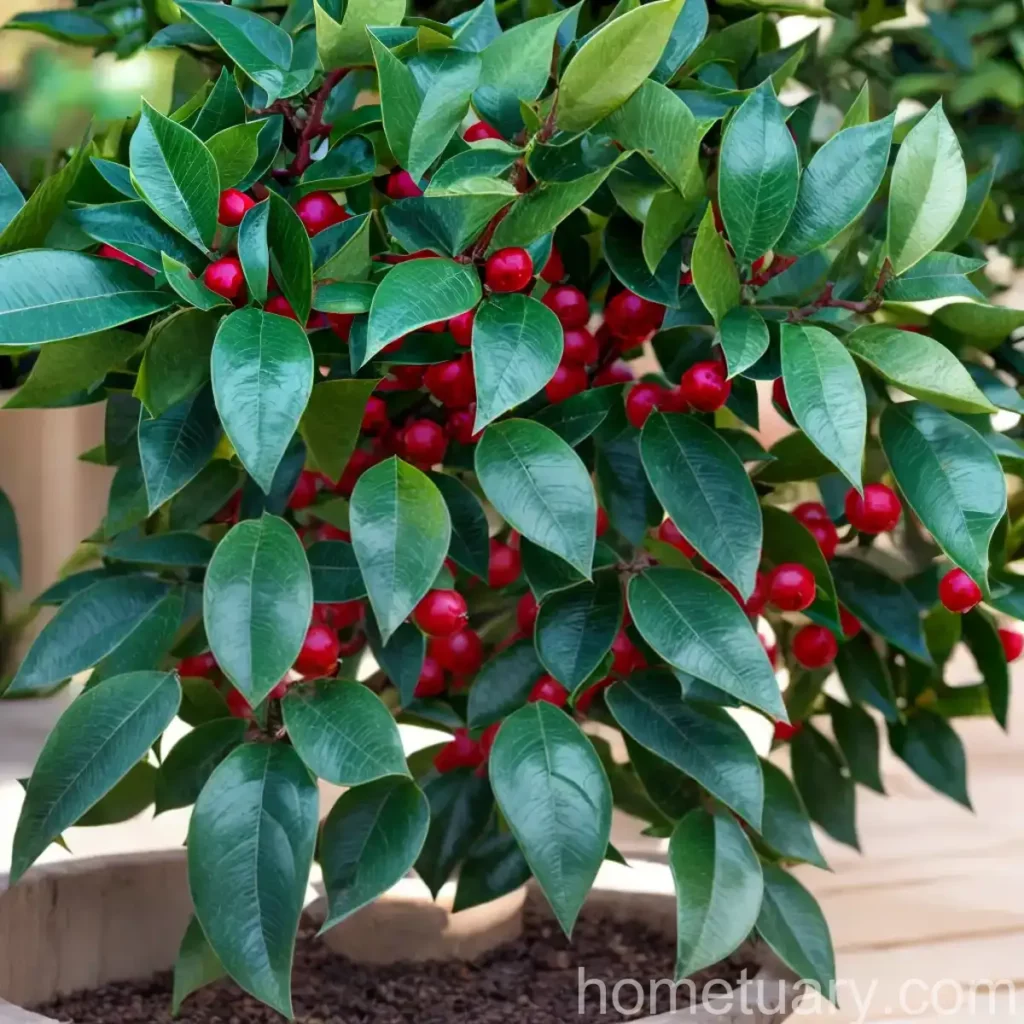American Holly (Ilex opaca ‘Mae’): An Overview
The American holly, scientifically known as Ilex opaca ‘Mae’, is a stunning evergreen plant with a rich historical and cultural significance. Renowned for its lustrous foliage and vibrant red berries, the American holly is a favorite among gardeners and landscapers. In this comprehensive guide, we will delve into the intricacies of this fascinating plant, exploring its cultural uses, optimal growing conditions, propagation techniques, common diseases and pests, and much more.
What is American Holly?
American holly, or Ilex opaca, is a broadleaved evergreen tree native to the eastern and south-central United States. It belongs to the Aquifoliaceae family and is characterized by its glossy, spiky leaves and bright red berries. The famous ‘Mae’ variety is esteemed for its compact growth habit and abundant production of vibrant berries, making it a sought-after ornamental plant for landscapes and gardens.
Key Takeaways – American Holly (Ilex opaca ‘Mae’)
Before diving into the specifics of American holly care and cultivation, here are the key takeaways about this distinguished plant:
- Scientific Name: Ilex opaca ‘Mae’
- Common Name: American Holly
- Plant Type: Evergreen tree/shrub
- Notable Features: Glossy, spiky leaves; red berries; compact growth habit
- Uses: Ornamental plant for landscapes, holiday decorations, medicinal purposes
- Cultural Significance: Symbolism in winter festivities, folklore, and traditional medicine
Now that we have a general understanding of this remarkable plant, let’s explore the intricacies of cultivating and caring for American holly.
Culture
Cultivating American holly involves more than just planting and watering; it requires a nuanced understanding of its growth habits, optimal conditions, and potential challenges. Below, we will delve into the cultural aspects of nurturing American holly for optimal health and vigor.
Uses
The uses of American holly extend beyond its ornamental value in landscapes and gardens. Here are some of its notable uses:
- Ornamental Plant: American holly is extensively utilized for its aesthetic appeal, adding visual interest to gardens, parks, and natural landscapes.
- Holiday Decorations: The vibrant red berries and evergreen foliage make American holly a popular choice for festive decorations, especially during the winter holidays.
- Medicinal Purposes: In traditional medicine, various parts of the American holly plant have been used for their purported medicinal properties, although caution should be exercised due to potential toxicity.
Water
Water is crucial for the establishment and ongoing health of American holly plants. While this species is relatively drought-tolerant once established, adequate moisture is essential, particularly during the initial growth stages and in periods of prolonged dryness.
- Establishment: Newly planted American holly specimens should receive regular watering to support root development and overall growth. Aim for consistent soil moisture without waterlogging the roots.
- Mature Plants: Once established, American holly generally requires less frequent watering, especially if planted in well-draining soils. However, during extended dry spells, supplemental watering can help maintain the plant’s vitality and promote berry production.
Sunlight
Proper sunlight exposure is instrumental in ensuring the healthy growth and fruiting of American holly plants. As a general rule, these plants thrive in locations with ample sunlight, though they can also tolerate partial shade, especially in hotter regions.
- Full Sun: Ideally, American holly should be planted in locations that receive full sun for a significant portion of the day. This promotes robust growth, lush foliage, and prolific berry production.
- Partial Shade: In regions with intense summer heat, providing partial shade during the hottest part of the day can help prevent heat stress and maintain the plant’s overall vigor.
Fertilizer
Appropriate fertilization can significantly enhance the growth and ornamental value of American holly. By understanding the fertilizer needs of this species, gardeners can ensure that their plants receive the essential nutrients for optimal health and vigor.
- Nutrient Requirements: American holly plants benefit from a balanced, slow-release fertilizer designed for acid-loving plants. Look for formulations specifically tailored for evergreen trees or shrubs.
- Application Timing: Fertilize established American holly plants in early spring before the onset of new growth. Avoid excessive fertilization, as this can lead to imbalances and adverse effects on the plant’s health.
Soil
The soil in which American holly is planted plays a critical role in its overall health and performance. Understanding the preferred soil conditions of this species is crucial for successful cultivation and long-term maintenance.
- Acidic Soil: American holly thrives in well-draining, acidic soils with a pH range of approximately 5.0 to 6.5. Soil tests can help determine the pH of the planting site and guide the necessary amendments for achieving the optimal acidity.
- Organic Matter: Incorporating organic matter such as compost, peat moss, or well-rotted manure into the planting area can improve soil structure and fertility, creating a favorable environment for American holly’s root development.
Pruning
Pruning is an essential aspect of American holly care, primarily aimed at maintaining a pleasing shape, removing dead or diseased branches, and promoting dense growth and berry production.
- Timing: Prune American holly trees or shrubs during late winter or early spring before new growth emerges. This timing minimizes the risk of disrupting the plant’s natural growth cycle and ensures rapid healing of pruning wounds.
- Techniques: Use sharp, clean pruning shears to make precise cuts, avoiding unnecessary damage to the plant. Focus on selective pruning to maintain the plant’s natural form while addressing any overgrowth or wayward branches.
Propagation
For those interested in propagating American holly, several methods can be employed to cultivate new plants. Understanding the propagation techniques for this species can enable gardeners to expand their holly collection or share these remarkable plants with others.
- Seed Propagation: Harvest ripe berries from healthy American holly plants, and extract the seeds for propagation. Sow the cleaned seeds in a well-draining potting mix and provide the requisite moisture and warmth for germination.
- Cuttings: Semi-hardwood cuttings taken in late summer or early autumn can be rooted to produce new American holly plants. Employ a rooting hormone to enhance the success rate of the cuttings, and provide the necessary environmental conditions for root development.
Container Popularity
American holly is well-suited for container cultivation, adding a touch of elegance and seasonal charm to patios, decks, and other outdoor living spaces.
- Ornamental Value: Planted in containers, American holly serves as a stunning focal point, especially during the winter months when its vibrant berries and evergreen foliage provide visual interest.
- Versatility: Container-grown American holly can be positioned strategically to enhance the aesthetics of outdoor seating areas, entryways, or garden landscapes, offering flexibility in design and placement.
Container Common Diseases
While container-grown American holly plants are generally less susceptible to certain soil-borne diseases, they may still face challenges related to moisture, nutrient availability, and environmental stress.
- Root Rot: Overly wet or poorly drained potting mix can predispose container plants to root rot, leading to wilting, yellowing foliage, and overall decline. Use well-draining potting media and avoid overwatering to mitigate this risk.
- Nutrient Imbalance: In containers, nutrient levels can fluctuate more rapidly, potentially causing deficiencies or toxicities. Regularly monitor and adjust the fertilization regimen to ensure that the plant’s nutritional needs are met without excess.
Disease Diagnosis
Diagnosing and addressing diseases in American holly plants is crucial for preserving their health and vitality. Familiarizing oneself with common diseases and their telltale symptoms can aid in early detection and timely intervention.
- Phytophthora Root Rot: Symptoms include wilting, yellowing foliage, and dieback, often accompanied by dark, water-soaked lesions on the roots. Improve drainage and avoid overwatering to mitigate this condition.
- Tar Spot: Characterized by black, tar-like spots on the leaves, this fungal disease can be managed through proper sanitation and, if necessary, targeted fungicidal treatments.
Common Pests
American holly plants are generally resistant to most pests, but certain insects can pose occasional challenges, particularly in stressed or weakened specimens.
- Spider Mites: These tiny arachnids can cause stippling and discoloration on the leaves. Regularly inspect the foliage, and employ tactics such as hosing down the plant or introducing natural predators to manage spider mite populations.
- Scale Insects: Scales may infest American holly, appearing as small, immobile bumps on the stems or leaves. Horticultural oil applications can help control scale insect populations without harming beneficial insects.
Botanist’s Tips
As a plant scientist specializing in horticulture and botanical conservation, here are some valuable tips for successfully cultivating and caring for American holly:
- Site Selection: Choose a well-draining location with ample sunlight for planting American holly, and consider its long-term growth habit to prevent potential overcrowding or interference with structures.
- Mulching: Apply a layer of organic mulch around the base of American holly plants to conserve soil moisture, moderate temperature fluctuations, and deter competitive weeds.
- Integrated Pest Management: Embrace holistic pest management strategies, emphasizing biological controls, cultural practices, and selective pesticide use only when necessary to maintain a balanced ecosystem and protect beneficial organisms.
Fun Facts
To enrich your appreciation for this iconic plant, here are some captivating and lesser-known facts about American holly:
- Wildlife Habitat: American holly provides valuable food and cover for various wildlife species, including songbirds, wild turkeys, and small mammals, contributing to the ecological diversity of natural habitats.
- Pollination: The striking red berries of American holly are the result of pollination by bees, which play a vital role in ensuring fruit set and seed production.
- Winter Interest: With its evergreen foliage and festive berries, American holly adds a touch of color and cheer to winter landscapes, serving as a living symbol of the season’s festivities.
Links to External Resources
For further exploration of American holly and related topics, I recommend checking out the following resources:
- The American Holly Society: An organization dedicated to the conservation, cultivation, and promotion of American holly and its horticultural value.
- USDA Plants Database: Ilex opaca: Detailed information on the botanical characteristics, distribution, and ecological significance of Ilex opaca as documented by the United States Department of Agriculture.
- University of Florida Gardening Solutions: American Holly: Practical guidance on growing and maintaining American holly, including advice on pest management, pruning, and landscape uses.
In conclusion, American holly, exemplified by the ‘Mae’ variety, is a compelling and versatile plant with enduring cultural and ecological significance. By understanding and applying the principles of care outlined in this guide, enthusiasts and horticulturalists can cultivate thriving American holly specimens, enhancing the beauty and biodiversity of their outdoor spaces while perpetuating the legacy of this iconic species.















